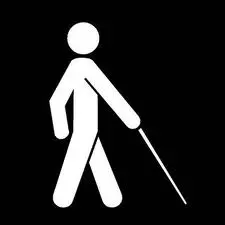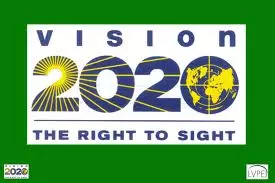
What is blindness?
Blindness is essentially the inability to see well enough to be able to have a reasonable quality of life. It does not necessarily have to mean not being able to see absolutely anything at all. It is the worst outcome of any eye disease.
The standard definitions from the World Health Organization (WHO) are listed in the table below. This definition is internationally accepted and incorporated into the International Statistical Classification of Diseases and Related Health Problems, 10th Revision (ICD-10).
World Health Organization (Who) definition
| Category | Worse than: | Equal to or better than: |
| Visual impairment – Mild or none (Score: 0) | 6/18 20/60 | |
| Visual impairment – Moderate (Score: 1) | 6/18 20/60 | 6/60 20/200 |
| Visual impairment – Severe (Score: 2) | 6/60 20/200 | 3/60 20/400 |
| Blindness (Score: 3) | 3/60 20/400 | 1/60 20/1200 Counting fingers at 1 meter |
| Blindness (Score: 4) | 1/60 20/1200 Counting fingers at 1 meter | Light perception |
| Blindness (Score: 5) | No light perception | No light perception |
These criteria are based upon testing of the vision with the Snellen chart.With the standard Snellen chart, vision is tested at a distance of 6 meters or 20 feet. The ‘normal’ visual acuity is 6/6 or 20/20.
6/6: seeing at 6 meters what the average person sees at 6 meters
20/20: seeing at 20 feet what the average person sees at 20 feet
6/18: seeing at 6 meters what the average person sees at 18 meters
20/60: seeing at 20 feet what the average person sees at 60 feet
6/60: seeing at 6 meters what the average person sees at 60 meters
20/200: seeing at 20 feet what the average person sees at 200 feet
3/60: seeing at 3 meters what the average person sees at 60 meters
20/400: seeing at 20 feet what the average person sees at 400 feet
1/60: seeing at 1 meters what the average person sees at 60 meters
20/1200: seeing at 20 feet what the average person sees at 1200 feet
When the vision is so poor that the Snellen chart cannot be used for visual acuity testing, then it can be estimated with counting fingers at 1 meter. One or two fingers are placed 1 meter in front of the patient, and the patient is asked to count the number of fingers that are shown.
Light perception is used when vision is worse than counting fingers. A bright light is shone on to the eye and the patient is asked if any light is noticed. The eye is considered to be completely not working if it cannot perceive any light that is directly shone at it.

Vision2020 is a global iniative to eliminate avoidable causes of sight loss worldwide.
Definitions Of Blindness
The legal definition of blindness varies slightly from country to country. In the United States, Canada and most European countries, this is defined as:
– Best-corrected visual acuity of 20/200 (6/60) or worse in the better eye
– Visual field of 20 degrees or less
So you are considered legally blind when you are not able to see more than the top letter on the Snellen chart, even when wearing correctly prescribed spectacles or contact lenses. An important consideration is your peripheral field of vision. Even though you may have excellent visual acuity, if your peripheral visual field is constricted to no more than 20 degrees, you are also considered legally blind.
In the United Kingdom, you are eligible for blind registration if your visual acuity is 10/200 (3/60) or worse (instead of 20/200). This means not being able to read the top letter on the Snellen eye chart. While in Australia, you are considered blind if your peripheral visual field is reduced to 10 degrees or worse (instead of 20 degrees).
Not surprisingly, not being able to see will impact significantly on your quality of life. At this level of vision, you will not be allowed to drive. You will not be able to make out bus numbers until the bus is around 1 meter in front of you. You will not be able read labels in the supermarket. Everything on the television is just a great big blur. It is very likely that you will not be able to recognize the facial features of your family and friends.
The fact that there are so many people who have lost vision worldwide suggests that despite medical and surgical advances in eye care, there are still conditions that cannot be treated or reversed. Prevention is still definitely the best approach. Taking good care of your eye health in the first place is far better than trying to cure eye diseases after they have occurred.
Learn the 7 steps of maintaining your vision and eye health here
However, if you or your loved ones have become visually impaired, all is not lost. There are various ways of coping with visual loss, including the use of low vision aids. Most countries have social services in place to help and support the visually impaired. There are many national and international support groups available that can provide practical advice and assistance.
It is still important to take care of whatever vision that remains, by either stopping or slowing down disease progression. Therefore, you will still need to work closely with your ophthalmologist to maintain the vision that you still have, no matter how poor you think that may be.
Note: The visual acuity and visual field criteria for driving is different compared to the criteria for registering you as being legally blind. In the United States and Australia, how well you need to be able to see to drive depends on the driving licensing legislature of the different states. In the United Kingdom, you need to be able to see 20/40 (6/12) or better to be able to drive. In Canada, you are ineligible to drive or are limited to daytime driving if you can’t see 20/50 (6/15) or better.
Learn more about the causes of blindness here


